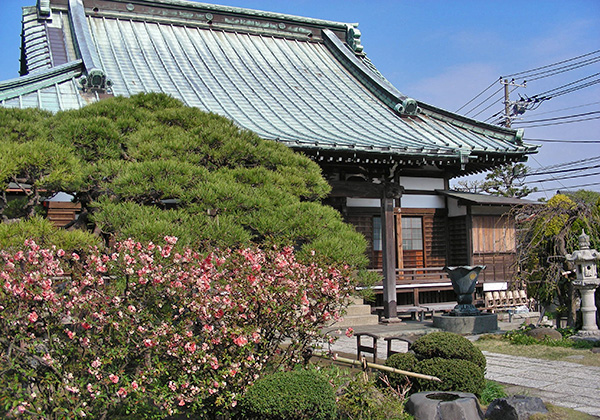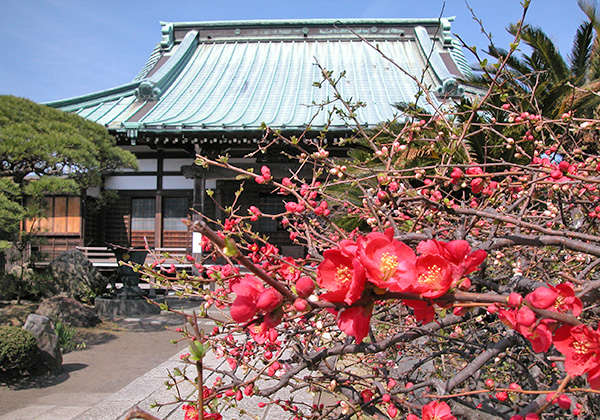Kuhonji
| Official Name | Dairisan Ryogaku-in Kuhonji {Pronounced dye-re-san ray-gok-in koo-hon-gee} |
|---|---|
| Religious sect | Komyoji school, Jodo sect, Buddhism |
| Founded | in 1336 by Yoshisada Nitta {yoh-she-sah-dah nit-tah} |
| Founding priest | Junsai Fuko {june-sigh foo-koh} |
| Main object of worship | Statues of Amida {ah-me-dah} Trinity |
| Address | 13-14, Zaimokuza 5-chome, Kamakura, Kanagawa 248-0013 (show route from current location ) |
| Location | 1,300 meters south of Kamakura Station |
| Time needed to get there | 20 minutes |
| Phone number | 0467-22-3404 |
| Restrooms | Not available |
Historical Overview
Background: Founder Yoshisada Nitta (1302-1338)
Founder Yoshisada Nitta (1302-1338) was a warlord in Gun'ma Prefecture, roughly 100 kilometers north of Tokyo. His ancestor was the same group as the Minamoto Clan. For the reason that his ancestors did not support Yoritomo Minamoto (1147-1199), the founder of the Kamakura Shogunate, when the Minamotos were fighting against the Taira Clan, Yoritomo did not give favors to them. The Nittas were treated badly and not happy at all for almost five generations. Even 150 years later, Yoshisada had hostility toward the Kamakura Shogunate. Hearing the news that Rokuhara, the stronghold of the Kamakura Shogunate in Kyoto, surrendered in 1333, Yoshisada and his troops rose in revolt against Kamakura. A number of other warlords who were no longer satisfied with Hojo regime also rose and joined the Nitta. Tens of thousands of warriors stormed to Kamakura to fight a battle against the troops of Kamakura Shogunate. A bitter battle developed particularly at the Inamuragasaki {e-nah-moo-rah-gah-sah-key} district, southwest part of Kamakura, where present-day Gokurakuji and Joju-in stand.
Strategically fortified, Kamakura was not easy to break in for the Nitta troops, and the furious battle continued for several days. But, Nitta and his troops finally succeeded in destroying the fortress. The Hojo regime, and the Kamakura Period, which lasted nearly 150 years, came to a tragic end. Nitta, who himself later had to commit suicide after the defeat in 1337, lamented that so many warriors, both friend and foe, were killed during the civil-war type battle. This was his motive to found Kuhonji at the site where he had placed his camp. The Temple opened three years after he conquered Kamakura.
About 600 meters northeast of the Temple where the road from the Temple crosses the Wakamiya-Oji main road stands the Kamakura Local Court and fast food restaurant McDonald's. This particular neighborhood was the bloodshed battleground. Recent excavation revealed hundreds of human skeletons which are obviously those of the war-dead were buried around here. After the investigation, those remains were carried to Kuhonji and entombed cordially.

Main Hall

Enshrined as the main object of worship are statues of Amida (Amitabha in Sanskrit) Trinity, Important Cultural Assets designated by the Municipal Government of Kamakura. Legend has it that the statue was made in Kyoto and was carried down here when the Temple was erected. Unfortunately, the interior of the hall is too dark and unable to make them out. On request, the statues can be viewed. Their appearance seem brand new, as they were gilt as recently as 1963.
The statue of Sho Kan'non or Arya-avalokitesvara in Skt., a 30 centimeters tall cast-metal, was made in 1812 and ranks 16th of the Kamakura Thirty-Three Kan'non Pilgrimage. The Temple also owns a stone statue of Yakushi Nyorai {yah-koo-she nyo-rye} or Bhaisajya-guru in Skt. It was made in 1296 and 96.5 centimeters tall. The stone statue of Yakushi Nyorai is rare in Kamakura, and the work is highly evaluated by connoisseurs. Made of one piece of andesite stone, it is designated as an ICA by Kanagawa Prefecture and is displayed at the Kamakura Museum.
Also owned by the Temple are statues of Enma (the Judge of Hell), or Yama in Skt., and Datsueba {dah-tsu-eh-bah}, one of the Ten Kings in the Netherworld. Those statue are not enshrined here, but are on view, like the Yakushi Nyorai statue above, at the Kamakura Museum.


